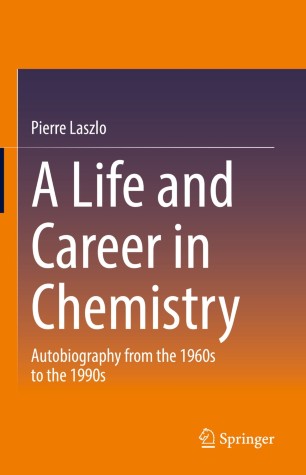Autobiography from the 1960s to the 1990s.
This book is an enthusiastic account of Pierre Laszlo’s life and pioneering work on catalysis of organic reactions by modified clays, and his reflections on doing science from the 1960s to 1990s. In this autobiography, readers will discover a first-hand testimony of the chemical revolution in the second half of the 20th century, and the author’s perspective on finding a calling in science and chemistry, as well as his own experience on doing science, teaching science and managing a scientific career.
During this period, Pierre Laszlo led an academic laboratory and worked also in three different countries: the US, Belgium and France, where he had the opportunity to meet remarkable colleagues. In this book, he recalls his encounters and collaborations with important scientists, who shaped the nature of chemistry at times of increased pace of change, and collates a portrait of the worldwide scientific community at that time. In addition, the author tells us about the turns and twists of his own life, and how he ended up focusing his research on clay based chemistry, where clay minerals were turned in his lab to catalysis of key chemical transformations. Given its breath, the book offers a genuine information on the life and career of a chemist, and it will appeal not only to scientists and students, but also to historians of science and to the general reader.
Pierre Laszlo is a French science writer and Professor of Chemistry Emeritus at the University of Liège (Belgium) as well as the École Polytechnique (Palaiseau, France) with earlier positions at Princeton University and the Université d’Orsay, and visiting professorships at the Universities of Connecticut, Kansas, California (Berkeley), Chicago, Colorado, Johns Hopkins, Lausanne, Hamburg, Toulouse and Cornell. He is especially known for his extensive work on nuclear magnetic resonance methodologies and catalysis of organic reactions by modified clays. As a writer, in addition to 10 scientific monographs and textbooks, his books to communicate science to the general public were awarded in 1999 the Maurice Pérouse Prize from the Fondation de France, and in 2004 the Paul Doistau- Emile
Blutet Prize from the French Academy of Sciences. Among Pierre Laszlo’s latest published books, the reader can find “Communicating Science. A Practical Guide” which was published by Springer in 2006.

The accompanying texts were written by my editors at Springer. This one aims at explanining my need for an autobiography and at underlining the interests it may hold, for readers and for historians of the recent period in science — my career took place from the 1960s to the 1990s.
I was graced from childhood with a wide-ranging curiosity. Hence, my steadfast
resolution to remain a generalist and not become a specialist. In a kindred spirit, I am not a joiner and have always steered clear of fashionable areas of science, however popular and crowd-pleasing. A value of this book may thus be for its lucidity, I hope to demonstrate with it a soundness of judgment.
I have been blessed with a good memory. Rather than reliance upon my recollections, though, I have given preference to the written record consisting in the ca. 60 notebooks (commonplace books) I kept over many years, throughout most of my career. This explains the style of this autobiography: terse; spontaneous and vivid; narrative, rather than descriptive. Whether waxing anecdotal or more philosophical, I have chosen a rather fluid writing style.
My scientific career took place in the context of what, in my considered opinion, can only be termed a Second Chemical Revolution. I feel very lucky to have witnessed and taken some, admittedly small, part in it. It was the best of times! I never worked bereft of enthusiasm. I felt part of an irresistible movement for a Renaissance in chemistry: devising new methodologies for the laboratory and opening-up new avenues for research and discovery. What came into play in so doing, and recounting it, is my sense of wonder and my capacity for admiration:
of people, my coworkers in particular; colleagues ; elegance in ideas and in making them manifest themselves; beauty in theories and experiments; likewise, in landscapes and countries I went through, in the course of lecturing.
To me, as an essential part of being a scientist, I took to teaching like a fish to water. I loved it. I was privileged with the caliber of students in the audience, from having taught in three of the 10 best universities in the world at the time (Princeton, Chicago and Cornell). My ease at the lectern was rewarded, not only with many a visiting professorship, even more importantly with lasting friendships, embracing colleagues and students both. The readers will visit, so to say, a gallery of marvellous educators. I wish them as much delight as came my
way from recording recollections of a splendid life and career.
It was not immediate. I let almost, a quarter of a century pass before attempting
the writing of this autobiography. Why and what good did it do, if any? The reason was my having been active in other endeavors, complementary to having been a scientist, namely writing articles and books of science popularization; also contributing to history of chemistry. Both these areas were successful and gave me much satisfaction. The time lapse in recording my recollections of my life as an active scientist may have been positive nevertheless: letting past events settle is a good way to put them into perspective and to let mediocre times and people fade into their deserved insignificance. Thus, of my entire career as a scientist — a proud chemist to boot — I have let only the radiance show.
